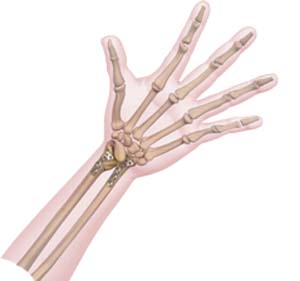
What is a Wrist Fracture?
The wrist is comprised of two bones in the forearm, the radius and ulna, and eight tiny carpal bones in the palm. The bones meet to form multiple large and small joints. A wrist fracture refers to a break in one or more of these bones.
Types of Wrist Fractures
The types of wrist fracture include:
- Simple, nondisplaced wrist fractures, in which the fractured pieces of bone are well aligned and stable
- Unstable fractures, in which fragments of the broken bone are misaligned and displaced
- Open (compound) wrist fractures, which are severe fractures in which the broken bones cut through the skin. This type of fracture is more prone to infection and requires immediate medical attention.
Causes of Wrist Fractures
Wrist fractures may be caused by a fall on an outstretched arm, vehicular accidents or workplace injuries. Certain sports such as football, snowboarding or soccer may also be a cause of wrist fractures. Wrist fractures are commonly associated with osteoporosis, a condition marked by brittleness of the bones.
Signs and Symptoms of Wrist Fractures
The common symptoms of a wrist fracture include severe pain, swelling, and limited movement of the hand and wrist. Other symptoms include:
- Deformed or crooked wrist
- Bruising
- Numbness
- Stiffness
Diagnosis of Wrist Fractures
Your doctor performs a preliminary physical examination followed by imaging tests such as an X-ray of the wrist to diagnose a fracture and check the alignment of the bones. Sometimes a CT scan may be ordered to gather more details of the fracture, such as soft tissue, nerves or blood vessel injury. MRI may be performed to identify tiny fractures and ligament injuries.
Treatment for Wrist Fracture
Your doctor may prescribe analgesics and anti-inflammatory medications to relieve pain and inflammation caused by a wrist fracture.
Fractures that are not displaced are treated with either a splint or cast to hold the wrist in place.
If the wrist bones are displaced, your surgeon may perform fracture reduction to align the bones. This is performed under local anesthesia. A splint or a cast is then placed to support the wrist and allow healing.
Surgery is recommended to treat severely displaced wrist fractures and is carried out under the effect of regional or general anesthesia. This is most commonly performed with open reduction and internal fixation with plates and screws.
Rehabilitation for Wrist Fracture Surgery
During the healing period, you may be asked to perform some motion exercises to keep your hand and wrist flexible. Your doctor may recommend hand rehabilitation therapy or physical therapy to improve function, strength and reduce stiffness.
Risks and Complications of Wrist Fracture Surgery
As with any procedure, wrist fracture surgery may involve certain risks and complications such as:
- Infection
- Residual joint stiffness
Arthritis
Related Topics
- Wrist Fracture
- Fractures of the Hand and Fingers
- Wrist Sprain
- Flexor Tendon Injuries
- Distal Radioulnar Joint (DRUJ) Arthritis
- Ulnar Nerve Compression in Guyon's Canal
- Scaphoid Facture
- Industrial Hand Trauma
- Distal Radius Osteotomy to Correct Mal-Union (Crooked Painful Wrist)
- Distal Intersection Syndrome
- Distal Biceps Avulsion
- Adult Forearm Fractures
- Arthritis of the Hand and Wrist
- Arthritis of the Thumb
- Ganglion Cyst
- Boutonniere Deformity
- Carpal Tunnel Syndrome
- De Quervain's Tendinosis
- Dupuytren's Contracture
- Hand Pain
- Hand Infections
- Trapeziometacarpal (TMC) Arthritis
- Wrist Injuries
- Wrist Tumors
- Boxer's Fracture
- Swan Neck Deformity
- Carpal Instability
- Bennett's Fracture
- Kienbock's Disease
- Scapholunate Dissociation
- Triscaphoid Joint Arthritis
- Ulnar Carpal Impaction
- Triangular Fibrocartilage Complex Injury (TFCC)
- Guyon's Canal Syndrome
- Hand Masses
- Distal Radioulnar Joint (DRUJ) Instability
- Work Related Hand Injuries
- Wrist Ligament Tear and Instability
- Metacarpophalangeal Joint Arthritis





